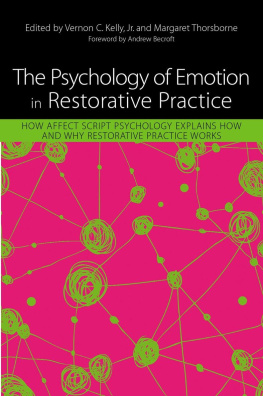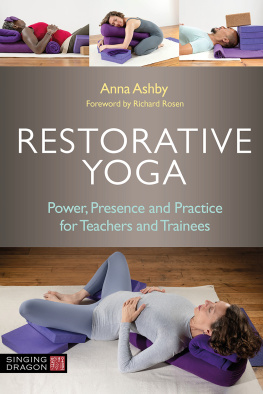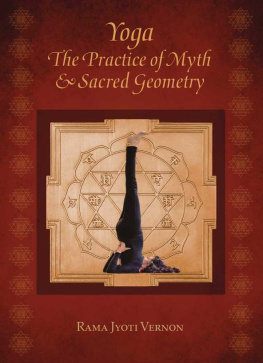The Psychology of Emotion in Restorative Practice
of related interest
Implementing Restorative Practices in Schools
A Practical Guide to Transforming School Communities
Margaret Thorsborne and Peta Blood
ISBN 978 1 84905 377 8
eISBN 978 0 85700 737 7
Just Schools
A Whole School Approach to Restorative Justice
Belinda Hopkins
ISBN 978 1 84310 132 1
eISBN 978 1 84642 432 8
Just Care
Restorative Justice Approaches to Working with Children in Public Care
Belinda Hopkins
Foreword by Jonathan Stanley
ISBN 978 1 84310 981 5
eISBN 978 0 85700 087 3
The Pocket Guide to Restorative Justice
Pete Wallis and Barbara Tudor
ISBN 978 1 84310 629 6
eISBN 978 1 84642 748 0
Restorative Justice
How it Works
Marian Liebmann
ISBN 978 1 84310 074 4
eISBN 978 1 84642 631 5
A Community-Based Approach to the Reduction of Sexual Reoffending
Circles of Support and Accountability
Stephen Hanvey, Terry Philpot and Chris Wilson
ISBN 978 1 84905 198 9
eISBN 978 0 85700 423 9
The Psychology of Emotion
in Restorative Practice
HOW AFFECT SCRIPT PSYCHOLOGY EXPLAINS HOW
AND WHY RESTORATIVE PRACTICE WORKS
Edited by Vernon C. Kelly, Jr. and Margaret Thorsborne
Foreword by Andrew Becroft
Jessica Kingsley Publishers
London and Philadelphia
The illustrations in are reproduced by permission of St Lukes Innovative Resources
First published in 2014
by Jessica Kingsley Publishers
73 Collier Street
London N1 9BE, UK
and
400 Market Street, Suite 400
Philadelphia, PA 19106, USA
www.jkp.com
Copyright Jessica Kingsley Publishers 2014
Foreword copyright Andrew Becroft 2014
All rights reserved. No part of this publication may be reproduced in any material form (including photocopying or storing it in any medium by electronic means and whether or not transiently or incidentally to some other use of this publication) without the written permission of the copyright owner except in accordance with the provisions of the Copyright, Designs and Patents Act 1988 or under the terms of a licence issued by the Copyright Licensing Agency Ltd, Saffron House, 610 Kirby Street, London EC1N 8TS. Applications for the copyright owners written permission to reproduce any part of this publication should be addressed to the publisher.
Warning: The doing of an unauthorised act in relation to a copyright work may result in both a civil claim for damages and criminal prosecution.
Library of Congress Cataloging in Publication Data
A CIP catalog record for this book is available from the Library of Congress
British Library Cataloguing in Publication Data
A CIP catalogue record for this book is available from the British Library
ISBN 978 1 84905 974 9
eISBN 978 0 85700 866 4
To
Donald L. Nathanson,
our colleague and friend, in honour of his extraordinary
contributions to our understanding of shame
Contents
Foreword
Andrew Becroft
Its not every day that one faces a charge of being the (partial) reason for a book being written. The authors of this text have laid exactly such an allegation against me. In this case, the dubious distinction is entirely an honour. I willingly plead guilty. My plea in mitigation is that, in November 2011, I was asked, as after dinner speaker, to address the combined Restorative Practices Internationals (RPI)/Restorative Justice Aotearoa (RJA) Conference in Wellington, New Zealand. The brief was to be provocative and challenging. Somewhat enthusiastically, and perhaps a little bluntly, I provided some reflections on restorative justice from the perspective of what we know in New Zealand as youth justice Family Group Conferences (FGCs). The first reflection was to suggest that, at least in New Zealand, we are strong on practice but short on theory, that we are practice-orientated and analysis/theory weak.
We New Zealanders like to think we know a thing or two about restorative justice. In 1989 the seminal Children, Young Persons and their Families Act 1989 (the CYPF Act) provided for FGCs, both as a diversionary mechanism for serious offences (where the police wish to charge a young person but cannot arrest him/her), and as a decision-making tool for virtually all important decisions in the Youth Court. They are triggered, and are mandatory, in the Youth Court, when a young person indicates that he/she does not deny the charge. This difficult-to-explain (especially to young offenders) double negative opens the door to a FGC. The aim of the FGC is to discuss how a young person can be encouraged to accept responsibility for the offending and be held accountable, and second, to recognize and address a young persons needs and the causes of the offending, so that the young person is given (in the powerful words of our legislation) the opportunity to develop in responsible, beneficial, and socially acceptable ways (Section (4)(f)(ii) of the CYPF Act).
Now it is worth noting that the words restorative justice were not even mentioned in the CYPF Act. It was 1989 after all. The concept was in its infancy and certainly not in vogue, at least for policy-makers and legislators. However, very quickly, the FGC, with its entitlement for victims and their supporters to attend, came to be practised along restorative justice lines. In one sense, in the very early 1990s, I am sure that many involved in facilitating FGCs did not even know that what they were doing was pioneering a restorative justice model. It took the rest of the world to tell us, and then researchers such as Drs Gabrielle Maxwell and Alison Morris, and judges such as Judge Fred McElrea, started to carefully describe and analyse our restorative practice and procedure.
It is also important to recognize that the FGC is not (as is sometimes unrealistically touted, and indeed hinted at wrongly in this book) the wholesale adoption of an indigenous M a ori method of dispute resolution and a rejection of the western legal system. The model certainly originated, in significant part, from the strong dissatisfaction by M a ori with the previous paternalistic/welfare-based child welfare and youth justice systems. And aspects of M a ori custom are incorporated into the FGC. For instance, in M a ori custom and law, tikanga o ng a hara (or the law of wrongdoing) is based on notions of collective rather than individual responsibility. Understanding why an individual has offended and addressing the causes collectively is seen as a benefit to society as a whole.
The wh a nau (or family) meeting model, used by extended families in some areas to resolve disputes, was seen as a prototype for a new method of resolving disputes in a way that was culturally appropriate for M a ori and also an empowering process for all New Zealand families. The adoption of this model accords with a shift in modern western legal systems towards alternative methods of dispute resolution, such as mediation. Two specific factors promoted participation by the young M a ori offender in the FGC process:
the inclusion of wh a nau (family), hap a (subtribe) and iwi (tribe) in repairing the harm; and
the opportunity to have the conference in chosen familiar surroundings, including on marae (traditional meeting area).
However, the FGC is better understood as a modern mechanism of justice that is culturally appropriate. It contains some elements of the traditional M a ori system of wh a nau decision-making, but also elements that are foreign to it (such as the presence of representatives of the State). It also modifies elements of the traditional system, such as the roles played by the family and victims. Nevertheless, these are important features of the system because M a ori children and young people comprise around half of all youth apprehended by the police in New Zealand, and over half of those prosecuted in the Youth Court.








